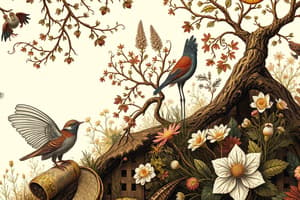Podcast
Questions and Answers
What is a species?
What is a species?
- All organisms of the same kind that are genetically similar enough to breed and produce fertile offspring (correct)
- A group of different species living together
- All organisms of the same kind that cannot reproduce
- All organisms living in a specific area at the same time
What defines a population?
What defines a population?
All members of a species living in a given area at the same time.
What is a biological community?
What is a biological community?
All populations of organisms living and interacting in a particular area.
Which of the following best describes an ecosystem?
Which of the following best describes an ecosystem?
Most ecosystems are open.
Most ecosystems are open.
What are producers?
What are producers?
What is productivity?
What is productivity?
What is primary productivity?
What is primary productivity?
What is secondary productivity?
What is secondary productivity?
Net primary productivity will be low if decomposers decompose organic material slowly.
Net primary productivity will be low if decomposers decompose organic material slowly.
What is a food chain?
What is a food chain?
What is a food web?
What is a food web?
What does trophic level refer to?
What does trophic level refer to?
What are consumers?
What are consumers?
What defines primary consumers?
What defines primary consumers?
What are tertiary consumers?
What are tertiary consumers?
What do secondary consumers eat?
What do secondary consumers eat?
What are herbivores?
What are herbivores?
What are carnivores?
What are carnivores?
What are omnivores?
What are omnivores?
What is biomass?
What is biomass?
What do scavengers do?
What do scavengers do?
What do detritivores consume?
What do detritivores consume?
Energy decreases as it moves up an ecological pyramid.
Energy decreases as it moves up an ecological pyramid.
What percent of energy in one consumer level is represented in the next higher level?
What percent of energy in one consumer level is represented in the next higher level?
What are cycles in ecology?
What are cycles in ecology?
What are tolerance limits?
What are tolerance limits?
What are environmental indicators?
What are environmental indicators?
What is convergent evolution?
What is convergent evolution?
What does habitat mean?
What does habitat mean?
What is an ecological niche?
What is an ecological niche?
What is resource partitioning?
What is resource partitioning?
What are predators?
What are predators?
What is coevolution?
What is coevolution?
What are parasites?
What are parasites?
What are pathogens?
What are pathogens?
What does symbiosis mean?
What does symbiosis mean?
What is commensalism?
What is commensalism?
What is mutualism?
What is mutualism?
What is Batesian mimicry?
What is Batesian mimicry?
Flashcards are hidden until you start studying
Study Notes
Species and Populations
- Species consist of organisms that can breed naturally and produce fertile offspring.
- A population refers to all members of a specific species residing in a particular area simultaneously.
Biological Communities and Ecosystems
- Biological communities encompass all interacting populations within a specific location.
- Ecosystems comprise both biological communities and their physical environments, which include abiotic (non-living) and biotic (living) factors.
- Most ecosystems are open, allowing for the exchange of materials and organisms with adjacent ecosystems.
Producers and Productivity
- Producers, such as green plants and algae, perform photosynthesis to generate energy.
- Productivity measures the amount of biomass produced in an area over a specified time.
- Primary productivity is driven by photosynthesis, while secondary productivity involves biomass creation by organisms consuming plants.
Food Chains and Food Webs
- Food chains represent a linked feeding sequence within an ecosystem.
- Food webs consist of interconnected food chains, illustrating the complex feeding relationships among various organisms.
Trophic Levels and Consumers
- Trophic levels indicate an organism’s position in the feeding hierarchy of an ecosystem.
- Consumers digest energy harnessed by producers and are classified into primary (plant eaters), secondary (eat primary consumers), and tertiary (top predators).
- Herbivores consume plants, carnivores eat meat, and omnivores feed on both plants and animals.
Ecological Concepts
- Biomass refers to biological material produced within an ecosystem.
- Scavengers clear decomposing remains of larger organisms, while detritivores consume dead organic material, litter, and dung.
- Energy decreases as it moves up the ecological pyramid, with only 10% of energy passed to the next level.
Biogeochemical Cycles
- Important cycles include the hydrologic, carbon, nitrogen, phosphorus, and sulfur cycles, essential for ecosystem function.
Environmental and Community Dynamics
- Tolerance limits determine the distribution of species, defined by minimum and maximum environmental factor levels.
- Environmental indicators, often bioindicators, provide insights into ecological changes.
- Resource partitioning occurs when two species compete for the same resource, resulting in one species prevailing.
Evolutionary Interactions
- Convergent evolution describes how unrelated species evolve similar traits.
- Predators target weaker members of prey populations, while coevolution highlights the reciprocal pressures species exert on each other.
- Parasites derive nutrients from hosts without causing death, while pathogens lead to disease.
Symbiotic Relationships
- Symbiosis encompasses intimate relationships between different species.
- Commensalism benefits one organism without affecting the other; mutualism provides benefits to both partners.
- Batesian mimicry occurs when harmless species evolve traits resembling unpalatable or harmful species for protection.
Studying That Suits You
Use AI to generate personalized quizzes and flashcards to suit your learning preferences.




